ONE RACER ASKS: WHY WASN’T ATLANTA SHUTDOWN UPDATED?
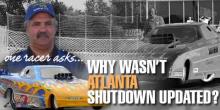 some
second-guessing. His thoughts have nothing to do with his decision to
continue racing and everything to do with wondering when the National
Hot Rod Association will concern itself with safety outside of the
POWERade ranks.
some
second-guessing. His thoughts have nothing to do with his decision to
continue racing and everything to do with wondering when the National
Hot Rod Association will concern itself with safety outside of the
POWERade ranks.Naves was supposed to have been alongside of Martindale on the fateful run but in an ironic twist a handful of safety issues kept him in the pits.
Naves 23-year old son witnessed the entire accident from start to finish. Matt Naves was a clear witness to Martindale’s car cutting through the catch net at NHRA-owned Atlanta Dragway before coming to an abrupt stop in the wooded area just outside of the sand-trap.
One racer asks questions following his friend’s death, the third in five weeks at NHRA-owned tracks …
Bill Naves has been racing Alcohol Funny Cars for almost 20 years, but after losing his friend Bobby Martindale he’s doing
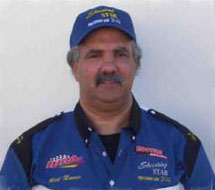
Naves was supposed to have been alongside of Martindale on the fateful run but in an ironic twist a handful of safety issues kept him in the pits.
Naves 23-year old son witnessed the entire accident from start to finish. Matt Naves was a clear witness to Martindale’s car cutting through the catch net at NHRA-owned Atlanta Dragway before coming to an abrupt stop in the wooded area just outside of the sand-trap.
Matt is no stranger to working with Top Alcohol Funny Cars, having been around the pits since he was 10 years old. He was promoted to his dad’s crew chief by age 18.
“Bobby trusted him and often asked to borrow my sons because they were good help,” Naves admitted.
Matt knows enough of the intricacies of the Alcohol Funny Cars to properly convey the account of the accident to his dad.
Naves knew all too well how treacherous the top end can be when a driver has deceleration issues.
A month ago Naves suffered a compound failure during the NHRA Carolinas Nationals at the new zMax Dragway. Both his rear brakes and parachute failed to engage. He hit the sand traveling in what he estimated to be faster than that Martindale was traveling.
“When I came through the traps in Charlotte, I was hot,” Naves said. “I was doing 230 and had nothing but front brakes. I hit that net and it picked me up and laid me back in the sand. I’m fighting with how it could have turned out so good for me and so bad for him. I was racing three weeks later.”
I think what is there in Charlotte should be a requirement, there should be two nets. I got up close and personal with that second net. A fuel car would’ve gone through to the second net. I don’t understand why the design wasn’t put into place immediately. Did they feel like they needed Top Fuel running there to validate the need? That would bother me if that were the case. - Bill Naves
a d v e r t i s e m e n t
Click to visit our sponsor's website
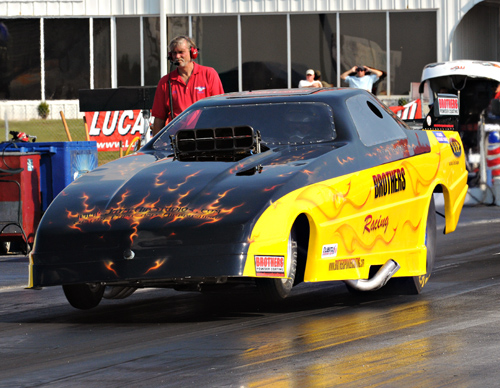
Naves didn't suffer serious injury and ironically, as he stood on the top end being attended to by the medical crew, he watched his car being towed back to the pits, minus the body, but rolling fine for the most part.
Martindale wouldn’t be as fortunate.
While Naves returned to competition in Commerce shaking down his rebuilt racer -- Martindale would never see the light of the next day.
An official cause of death has not been released as of this article, but without listing any details of the accident’s aftermath, blunt force trauma is likely the cause.
“He was a bit erratic on the starting line,” Naves conveyed from the testimony of his son. “Bobby has been driving for a long time and for him to have a problem at the other end on a 7.80 pass at 180 miles per hour, and do nothing at all to stop, makes no sense at all. That’s all beside the point, why didn’t the net stop him so they could check him out. There might have been a chance to help him otherwise.”
Sources have indicated the sand in the trap area was hard, akin to a dirt road.
Martindale’s death represented the third fatal crash in NHRA competition since Labor Day, at NHRA-owned facilities.
a d v e r t i s e m e n t
Click to visit our sponsor's website
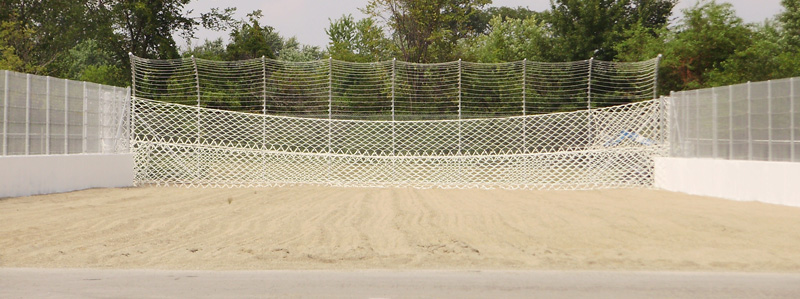
Steve Engel, of Shandon, Ohio, crashed during the NHRA U.S. Nationals
in Indianapolis, when his Pro Modified entry crashed through a concrete
barrier, forcing the suspension of racing activities until the next
day. Engel was airlifted from the crash scene and underwent multiple
surgeries during a critical condition hospital stay before succumbing
on September 14th, the result of injuries sustained in the crash.
Doug McRobie, of Mt. Eaton, Ohio, died on September 21st, when his
Super Gas roadster made contact with the shutdown retaining wall during
the NHRA sportsman national event at NHRA-owned National Trails Raceway
in Columbus, Ohio. He was extracted by NHRA medical personnel and
transported to a local hospital, where he was pronounced dead.
The common denominator in the these crashes was all three drivers made
contact with the concrete retaining barriers, leading some to wonder if
the time has come for Safer Barriers to become part of the NHRA’s
movement to build safer drag strips. Much of the focus has been
centered on the shutdown areas following nitro Funny Car racer Scott
Kalitta’s death in June at Englishtown, NJ.
Kalitta’s cause of death was blunt force trauma when his errant race
car struck a pole supporting the catch net and then a camera boom truck.
Eyewitness accounts described Martindale’s crash as one where he
exploded the engine in his Funny Car and made contact with the wall,
ejecting the body from the chassis. Once he cleared the sand and the
net, he careened into a wooded area past the shutdown area and actually
ignited a fire in the woods.
The question remains whether Martindale was adversely affected by the contact with the retaining wall.
NHRA officials shortened the racing surface as a temporary fix to slow
the nitro cars until adequate measures to slow the nitro-burners are
achieved.
These moves have had little effect on the Alcohol Funny Cars as they continue to compete on a quarter-mile race course.
a d v e r t i s e m e n t
Click to visit our sponsor's website
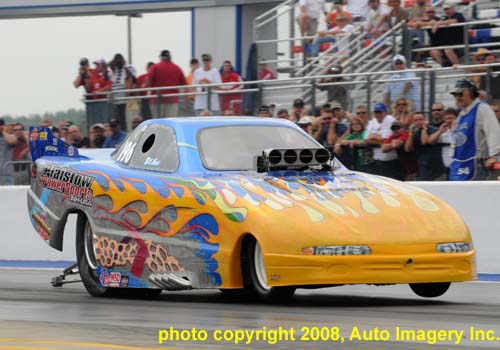
The new zMAX Dragway in Concord, North Carolina received the new system and reportedly Pomona, known for its short shutdown area, will be reworked by the end of 2008.
Naves just can’t understand why after his incident in Concord that a similar design wasn’t implemented immediately at Commerce and other tracks.
“Everyone should have looked at that video and said this is what we need right now,” Naves said, offering gratitude towards track owner Bruton Smith. “My family stood there in horror watching me end up upside down, only to be relieved when I got out of there okay and watched my car driven back to the pits. It’s phenomenal.
“I think what is there in Charlotte should be a requirement, there should be two nets. I got up close and personal with that second net. A fuel car would’ve gone through to the second net. I don’t understand why the design wasn’t put into place immediately. Did they feel like they needed Top Fuel running there to validate the need? That would bother me if that were the case.”
Naves' voice cracks with emotion when he continued with one statistic.
"I have been in a Funny Car every year since 1987 and I've raced at 60 different tracks and never reached the net until Concord," Naves said. "I've been up close and personal with the sand and the one net that picks me just happens to be the best one in the world. That just tears me up to think about that."
a d v e r t i s e m e n t
Click to visit our sponsor's website
A source well within the NHRA said a similar overhaul to the one
implemented in Indianapolis was already in the engineering stages for
Atlanta Dragway prior to the weekend’s accident. CompetitionPlus.com
has learned the redesigned sand-trap design could be in place before
the end of 2008 season.
The NHRA, CompetitionPlus.com has learned from multiple sources, will
require stringent minimum standards for the sand-traps to be
implemented before their 2009 season opens.
“The tracks will be safer than they ever have been,” said an NHRA
employee, who spoke to CompetitionPlus.com under the condition of
anonymity.
Seeing is believing for Naves, who remains emotionally bothered by the
situation. He’s convinced no action will be taken until it’s time for
the traveling professional show to roll into town.
“I want someone to explain to me how the NHRA can own a track and not
outfit it with the same safety stuff (that) Bruton Smith does,” Naves
asked. “Please explain to me how I’m here three weeks later, making
arrangements to attend his funeral because he drove through the catch
net and cut it in half. Is it because the fuel cars won’t be back until
spring?
“He was going 180 and I was going 230. Why wasn’t there sufficient net
to retain him from that tree line?” That’s what Naves wants to know.
One can only wonder, if the situation were reversed, what Martindale would say if Naves had been the one who perished that day.
One could draw a conclusion easily if they referenced an
InsideTopAlcohol.com message board post Martindale made on March 31,
2008. Bear in mind, this was well before the Kalitta crash.
[sic] “?????.nhra Wants All Of Us To Spend Money On Making Our Cars
Safe,when Are They Going To Make The Tracks Safe? My 2 Cents”
| {loadposition feedback} |






